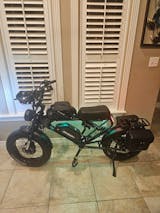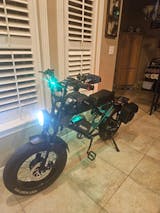Table of Contents
- 1. General EU Regulations for E-Bikes
- 2. Country-Specific Laws and Regulations
- 3. Key Considerations for Dual Motor E-Bikes
- 4. Benefits and Limitations of Dual Motor E-Bikes in Europe
- 5. Tips for Riders
- 1) Research Local Regulations:
- 2) Opt for Certified Models:
- 3) Ensure Proper Documentation: ements.
- 4) Wattage Limits Before Buying:
- 6. Conclusion
- 7. FAQ
Electric bikes with dual motor power (dual motor e-bikes) powered by two motors are more used by the European riders as a more versatile solution, since they provide more power and a better performance if the terrain is steep or if the route is difficult. They are popular with adventure enthusiasts as well as urban commuters in search of improved efficiency and versatility.
However, with their increasing popularity come questions regarding their legal standing. European regulations regarding dual motor e-bikes vary between countries and focus on speed limits, motor power and road classification - understanding these laws is critical in order to avoid fines, ensure road safety and enjoy an effortless ride that complies with regional legal requirements.
1. General EU Regulations for E-Bikes
Under EU law, e-bikes can be classified as pedal-assisted cycles if they meet certain criteria. Among them is that an e-bike must have an electric motor not exceeding 250W of power that assists while pedaling; additionally it should cut off when reaching 25 km/h (15.5 mph) speed limit and not require licenses, insurance or registration as they would a regular bicycle.
However, dual motor e-bikes, equipped with two motors for additional power and performance, may surpass the 250W power limit. If either motor exceeds this threshold, then stricter regulations would likely apply, including insurance requirements and registration regulations and compliance with road use laws.
Understanding regulations surrounding e-bike use on public roadways is vitally important to riders and buyers, to ensure their e-bike complies with local laws for road use. Failure to do so could result in fines, confiscation of their bike or inability to access certain public spaces - always check specifications and local laws prior to purchasing or using a dual motor e-bike.
2. Country-Specific Laws and Regulations
Europe-wide regulations regarding dual motor e-bikes vary significantly, as illustrated by this list:
Germany:
- E-bikes fall under Germany's "Pedelec" category which requires motor assistance only when pedaling - for instance Germany has regulations specific to pedal assisted bikes known as "pedelecs".
- Dual motor models are also subjected to a 250W power and 25 km/h speed restriction (for all e-bikes, including dual motor models). However, if they do not fit these parameters, it could be regarded as a motor vehicle, requiring licensing, insurance and roadworthy checks to be run on it before running it on public roads.
- Always check e-bike laws in Germany to ensure compliance with local rules.
France:
- Under French law, e-bikes cannot exceed 250W in motor power and the motor must turn off once reaching 25 km/h.
- Dual motor e-bikes may require special classification if they exceed standard power or speed limits. Some cities require additional road use classifications if exceeding legal power limits is present, with Italy mandating registration if exceeding 250W limit.
- This includes insurance and, in certain models, possibly even a driving license.
Scandinavian Countries:
- Norway and other Nordic nations have laws which allow slightly varying power limitations and usage regulations, for instance dual motor e-bikes might be subject to lower wattage limits or require specific safety standards.
- Check dual motor e-bike rules in Norway to gain more information about local restrictions and allowances.
Each country in Europe has their own interpretation of e-bike regulations; thus it's always wise to research local requirements before purchasing or riding an electric bicycle with two motors.
3. Key Considerations for Dual Motor E-Bikes
Dual motor e-bikes are built for power and performance, often outstripping standard e-bikes. Equipped with two motors--one on each wheel to improve traction, speed, and support on rough terrain--dual motor e-bikes provide enhanced traction, speed, and support on rough terrain terrains; however their increased power may lead to issues with standard regulations for standard e-bikes.
Power Limits:
- Standard e-bikes are limited to using 250W motors and having a maximum speed of 25 km/h (15.5 mph).
- Dual motor e-bikes may exceed these restrictions due to each motor having an output rated at or exceeding 250W; such bikes could breach basic e-bike laws and become noncompliant.
Insurance & Registration:
- Depending on your country of residence, dual motor e-bikes that exceed power limits may need insurance and registration - whether this means purchasing a license plate number or adhering to specific motorized vehicle regulations.
Safety Certifications:
- Dual motor e-bikes must meet higher safety standards, including certification of brakes, lights and motor reliability.
- Buyers should prioritize purchasing bikes that adhere to these safety requirements in order to guarantee both reliability and legal compliance.
Compliance Checks:
- To avoid fines and restrictions that are legal restrictions, prior to buying your region’s dual motor e-bike, you must do the compliance checks on its power and speed to make sure they are within legal parameters.
Dual motor e-bikes perform incredibly well and provide a good buy for the money, however riders must take care to ensure they comply with all legal and safety requirements for safe operation.
4. Benefits and Limitations of Dual Motor E-Bikes in Europe
Benefits of Dual Motor E-Bikes
Dual motor e-bikes are ideal for riders who need more power, especially in challenging conditions. These bikes provide a significant advantage in off-road or rugged terrains, making them popular for:
- Mountain biking: Dual motors help climb steep hills or uneven paths with ease.
- Rough terrains: They offer better traction and control on dirt roads or trails.
- Extended range: With the added power, dual motor e-bikes can cover longer distances with less effort, making them perfect for adventurers and commuters.
Limitations in Urban and Public Spaces
Dual motor e-bikes have numerous benefits, yet also may face legal restrictions which limit their usage in urban and public areas, creating opportunities for adventurers as well as commuters alike. Unfortunately, while dual motor e-bikes have benefits, they also face limitations:
- Speed and power limits: In urban areas, electric bikes exceeding 250W motor limits or 25 km/h speeds may be restricted for road use.
- Public road use: Some regions only permit basic power and speed restrictions as part of road usage rules for public road e-bikes.
- Road Access: Specific public areas such as bike lanes may limit road access for dual motor e-bikes for safety concerns and legal classification as motor vehicles.
Compliance Is Essential
Ensuring your dual motor e-bike meets legal power limits and road use laws is of utmost importance, to allow riders to enjoy its full benefits without risking fines or restrictions in public spaces.
5. Tips for Riders
To avoid legal complications and ensure compliance with local regulations and avoid legal issues when considering dual motor e-bikes, here are a few practical tips for riders considering dual motor e-bikes:
1) Research Local Regulations:
- Before purchasing or importing a dual motor e-bike into your country or region, always conduct extensive research into any relevant legislation that applies.
- Check wattage limits, speed restrictions and registration requirements to avoid fines or confiscation of your device.
2) Opt for Certified Models:
- To ensure safe and legal operation of an e-bike, opt for models certified to EU or country standards. Certified models will more likely adhere to local laws ensuring they remain compliant and safe to ride.
- Search for bikes with appropriate safety certifications, such as meeting all braking and lighting requir
3) Ensure Proper Documentation: ements.
- When making modifications such as changing motor power, make sure all documentation remains on file to prove compliance.
- Some modifications may require re-registration or additional insurance, so always check.
4) Wattage Limits Before Buying:
- Always confirm motor power and speed before making a decision to ensure it falls within legal requirements to avoid complications down the road.
- Note that going beyond power limits may require special registration or subject your bike to different vehicle laws.
By following these recommendations, your dual motor e-bike will remain legal and safe to ride; giving you peace of mind during each ride.
6. Conclusion
In summary, understanding and following local laws when riding a dual motor e-bike in Europe is paramount to enjoying safe travels on public spaces. Every country has different restrictions regarding power limits, speed restrictions, road classifications and registration requirements that must be observed to legally ride your e-bike on public spaces. Failing to abide by them could incur fines or registration requirements which prevent future use.
By prioritizing safety and legality, dual motor e-bike owners can maximize the performance advantages without risking legal complications. Always check local regulations, select certified bikes, and ensure proper documentation when making modifications - following this path will lead to an enjoyable riding experience while staying legal across Europe.
7. FAQ
1) Are dual motor e-bikes legal on public roads in Europe?
Bikes powered by two motors may be allowed on public roads in Europe if they follow local regulations regarding power limits and speed restrictions, according to Europe. In the case of an e-bike that, due to its motor power is wider than this legal limit, however, it could be classified as a motor vehicle and thus be required to be insured and registered.
2) Can I modify my dual motor e-bike to exceed legal power limits?
Yes, but exceeding legal power limits (usually 250W) could lead to stricter regulations including registration, insurance and driving license restrictions. Before making modifications that may exceed these laws and avoid legal issues.
3) Do I Need a License for Riding an Electric Bicycle in Europe?
Most European countries allow the use of dual motor e-bikes which adhere to the rules (250W motor, 25 km/h speed limit) without a license, however yours may require it if it exceeds motor vehicle law.
4) What steps should I take if my dual motor e-bike exceeds the legal power limit?
If your dual motor e-bike exceeds its legal power limit, you may need to register it as a motor vehicle, obtain insurance coverage and comply with roadworthy requirements. Please check local regulations for necessary actions and ensure it meets safety and registration standards prior to any legal use of it.




















